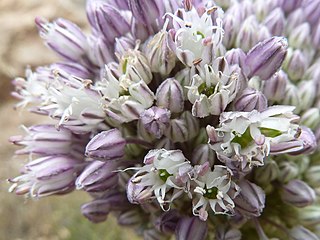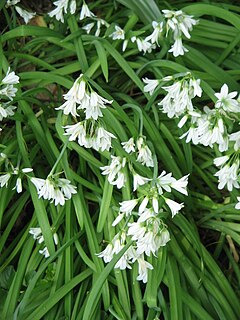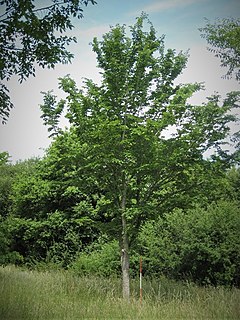
Allium ursinum, known as wild garlic, ramsons, buckrams, broad-leaved garlic, wood garlic, bear leek or bear's garlic, is a bulbous perennial flowering plant in the amaryllis family Amaryllidaceae. It is native to Europe and Asia, where it grows in moist woodland. It is a wild relative of onion and garlic, which belong to the same genus as wild garlic, Allium.

Stefano Delle Chiaje was an Italian zoologist, botanist, anatomist and physician.

Allium ampeloprasum is a member of the onion genus Allium. The wild plant is commonly known as wild leek or broadleaf wild leek. Its native range is southern Europe to western Asia, but it is cultivated in many other places and has become naturalized in many countries.

Allium triquetrum is a bulbous flowering plant in the genus Allium native to the Mediterranean basin. It is known in English as three-cornered leek, and in Australia and New Zealand as onion weed. Both the English name and the specific epithet triquetrum refer to the three-cornered shape of the flower stalks.

Vincenzo Petagna was an Italian biologist, physician and entomologist. He was appointed as director of Monte Oliveto botanical gardens. He was also the teacher of Antonio Savaresi. The plant Petagnaea gussonei has been named after him.

Allium amplectens is a species of wild onion known by the common name narrowleaf onion. It is native to British Columbia, Oregon, Washington State and California, where it grows in woods and especially in clay and serpentine soils.

Allium fimbriatum is a species of wild onion known by the common name fringed onion. It is native to California and Baja California.

Michele Tenore was an Italian botanist active in Naples, Italy.

Allium yosemitense is a California species of wild onion known by the common name Yosemite onion. Most of the known populations are situated within the boundaries of Yosemite National Park.

Vincenzo de Cesati (1806–1883) was an Italian botanist from Milan.

Ulmus 'Morfeo' is a hybrid elm cultivar raised by the Istituto per la Protezione delle Piante (IPP), Florence, in 2000. 'Morfeo' arose from a crossing of the Dutch hybrid clone '405' and the Chenmou Elm, the latter a small tree from the provinces of Anhui and Jiangsu in eastern China, The '405' clone is a full sister of 'Groeneveld', a crossing of an English U. × hollandica and a French U. minor from the Barbier Nursery, Orléans.

Allium paniculatum, common name pale garlic It is widely cultivated and is now naturalized in several places outside its native range.
Allium hemisphaericum is a species of onion endemic to the Island of Sicily in the Mediterranean.
Allium lehmannii is a plant species endemic to southern Italy. It is found only the Island of Sicily in the Mediterranean and in the nearby Calabria region of the Italian mainland.

Allium nebrodense is a rare Italian species of wild onion. It is found only on the Island of Sicily in southern Italy.

Allium pallens is a species of wild onion native to the Mediterranean region and Middle East from Portugal and Algeria to Iran.

Allium trifoliatum, commonly called pink garlic and Hirsute garlic, is a Mediterranean species of wild onion. It is native to France, Cyprus, Malta, Italy, Greece, Egypt, Turkey, Lebanon, Palestine, and Israel.
Galium glaucophyllum, the Sardinian bedstraw, is a species of plant in the family Rubiaceae. It is endemic to the island of Sardinia in the Mediterranean.
Antonino Borzì was an Italian botanist.

Vitangelo Bisceglia was an Italian botanist, agronomist and professor. He taught inside the University of Altamura. Because of his being a polymath, he's been described as "an encyclopedic spirit, the honor of the Muses".















